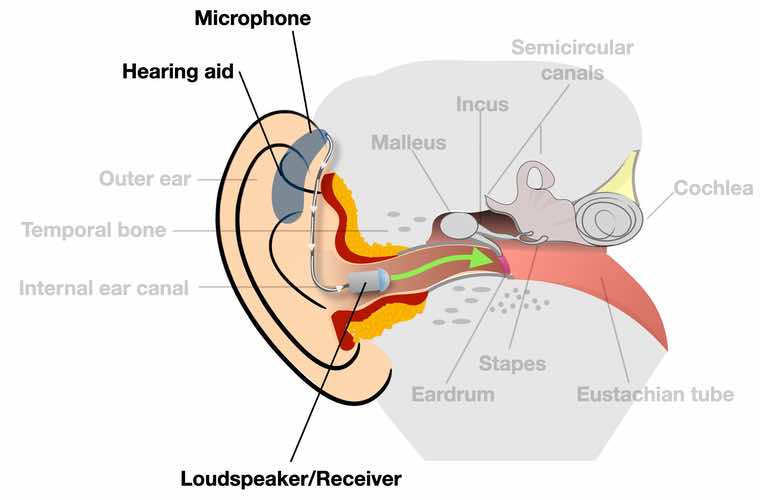Modern digital hearing aids work by amplifying the sound to a needed level so the wearer can hear better. The needed level of amplification is called hearing loss and is individually adjustable to the wearer. In most cases this means higher-pitched sounds get another level of amplification as the mid and lower-pitched sounds.
The hearing aids consist of four main parts: A microphone, processor, speaker, and battery. The microphone picks up the sounds from the environment, i.e. the acoustic signals, and forwards them to the processor. This amplifies the sounds and converts them into electrical signals. And the loudspeaker, also called the receiver, forwards the signals to the wearer’s ear canal. There, the sound hits the eardrum and can be clearly heard again by the wearer.
Modern hearing systems work binaurally. This means two hearing aids on the left and right practically form a system via a wireless connection. This significantly improves your spatial orientation and makes the hearing aids more capable of amplifying a certain area in front of you more and the sides and the back less.
This way you can hear better in a noisy environment. The hearing aids of the new generation can be controlled intuitively via your smartphone. Hearing aids automatically decide how much amplification is needed in a certain situation. That means when someone is whispering the wearer receives more amplification and in contrast, the hearing aid will turn down amplification levels when the environment is already very loud.
A basic distinction is made between three different types of hearing aids, which, depending on their design, are located directly in the ear or behind the ear. In the case of an in-the-ear device, all three components are located directly in the small earpiece, which is placed in the inner ear.

In the classic behind-the-ear device, all components are located behind the ear. The sound is then transported through a thin sound tube to the earpiece of the device. The so-called RIC (Receiver-in-Channel) device works in a similar way. The microphone and the amplifier are located behind the ear, but the loudspeaker is located directly in the earmold or. in the ear itself. But all of the hearing aids basically work the same way.
Due to the slight modification of the construction, a RIC device can be built smaller than a classic behind-the-ear hearing aid.
Hearing Aids and the Limitations of Them (When They Do Not Work)
Hearing aids are extremely capable devices but for some people they do not work. The causes therefore are different. In some cases the hearing loss is too extreme so the hearing aids can not meet the amplification levels. In such a case a implant could be a viable alternative to hearing aids. In other cases amplification or prescriptive targets can be met but speech is still hard to understand.
In this case, the problem is not located in the ear but in some cases, the nerve that is transmitting the signals to the brain is not properly working anymore. Or the brain itself can not process auditory information properly. In such a case it would not be beneficial to raise volume because the actual understanding of speech would not be better.
This means there are indeed people with hearing loss where a hearing aid will not work or will not work as good compared to other wearers.
A sucessful hearing aid fitting enables the full potential of understanding speech again. For some people this means they understand 40% without hearing aids and 100% with hearing aids. But other people hear 40% without hearing aids and understand 50% at best when having the haring aids inserted.
This of course will probably not lead to a satisfied wearer although everything has been done the same in both examples. The problem, in this case,is the ability to process sound. This is a big problem and becomes more common when the noise you actually do not want to hear gets nearly as loud as your conversational partner. People with a hearing loss tend to have more problems in those situations compared to the ones without a hearing loss.
This means even though a hearing aid is worn by the person is with hearing loss a really noisy environment oftentimes leads to concentration problems and taxes people more. Hearing aid manufacturers combat hearing fatigue with different technologies like directional microphones and get better at it with every new hearing aid generation. But a person with hearing loss and hearing aids will not get the hearing back as it was before the hearing loss.
Listening effort and therefore hearing fatigue is higher with a hearing loss which was also concluded In a study done by Barbara Ohlenforst in 2017. This is where even high-end hearing aids seem to not work optimally. But the problem here is not the adjustment of the hearing aids it is the filter in the brain that can not distinguish between noise and speech as good anymore.
Here you have the information on hearing aids and how they work and when they tend to work not so well. In case if you are thinking about hearing aids make an appointment with your local audiologist and see what information he or she has for you. Only the hearing care specialist who did the measurements and looked in your ears can recommend a hearing aid or an alternative treatment for you.
I wish you a great day.
